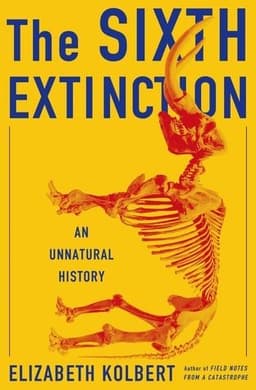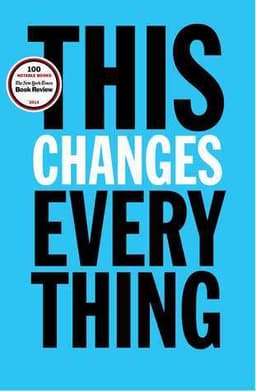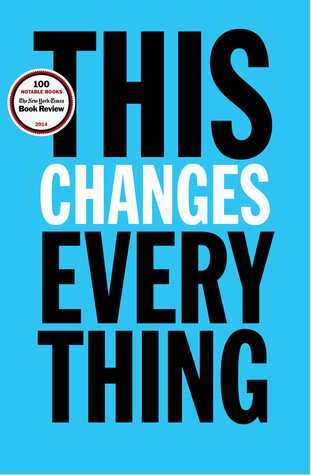
The Sixth Extinction Book Summary
An Unnatural History
Book by Elizabeth Kolbert
Summary
In "The Sixth Extinction," Elizabeth Kolbert takes us on a riveting journey through the tumultuous history of life on Earth, revealing how human activity is driving a catastrophic modern extinction event that may ultimately imperil our own survival.
Sign in to rate
Average Rating: 1
Panamanian Golden Frog Driven to Brink of Extinction
The Panamanian golden frog, once prevalent in streams near El Valle, has been nearly eradicated by a deadly fungal disease called chytridiomycosis. This disease, caused by the chytrid fungus Batrachochytrium dendrobatidis (Bd), has spread across Panama, decimating frog populations.
Scientists quickly gathered the remaining golden frogs to create a captive breeding program, housing them initially in a "frog hotel" and later at the El Valle Amphibian Conservation Center. Despite these efforts, the species is now extinct in the wild, underscoring the severity of the global amphibian extinction crisis.
Section: 1, Chapter: 1
Current Extinction Rate Far Exceeds Historical Background Rate
The current rate of species extinction is estimated to be 100 to 1000 times higher than the background extinction rate, which is about 0.1 extinctions per million species per year. Amphibians have been hit especially hard, with an extinction rate as much as 45,000 times the background rate. This means we are likely in the midst of the sixth mass extinction in Earth's history, this time primarily caused by human activities. Species are disappearing so fast that biologists feel they are "running through a museum and knowing that the collection's on fire."
Section: 1, Chapter: 1
Characteristics of Mass Extinctions According to Paleontologists
Paleontologists have identified several key characteristics of mass extinction events:
- Significant proportion of the world's biota eliminated in a geologically short time frame (Hallam and Wignall)
- Substantial biodiversity losses occurring rapidly and globally (Jablonski)
- Vast swathes of the tree of life cut short simultaneously, as if attacked by "axe-wielding madmen" (Benton)
- Long periods of stasis in extinction rates punctuated by sudden spikes in species loss (Raup)
While causes and speed vary between the "Big Five" mass extinctions, they share devastating consequences across many taxa and ecosystems worldwide.
Section: 1, Chapter: 1
Cuvier Discovers Extinction and a Pre-Human "Lost World"
In revolutionary France, naturalist Georges Cuvier studied fossilized elephant and mastodon bones, including specimens discovered in North America. He recognized that their anatomy was distinct from living species. This led him to propose that some species had gone extinct - a radical idea at the time. He identified the mastodon, mammoth, giant ground sloth, and more as "lost species." Cuvier envisioned a pre-human world populated by unfamiliar creatures that had been wiped out by sudden catastrophes.
His work established extinction as a scientific fact and the existence of a "former world" before humans, though his catastrophist views were later overturned.
Section: 1, Chapter: 2
"The Present Is the Key to the Past": Lyell's Uniformitarian Geology
"The present is the key to the past."
This famous maxim encapsulates geologist Charles Lyell's uniformitarian view. He argued the same gradual geological processes observable today, like erosion and sedimentation, shaped Earth's features over immense time. This contrasted with Cuvier's catastrophism. Lyell claimed the apparent "revolutions" in the fossil record simply reflected its incompleteness. Species extinctions occurred piecemeal, not en masse. Lyell's "Principles of Geology" was hugely influential, though he was ultimately wrong about the continuity of the fossil record and the ability of modern causes to explain mass extinctions.
Section: 1, Chapter: 3
Darwin Confronts the Contradiction of Human-Caused Extinctions
Darwin recognized some species went extinct suddenly, like the great auk and ammonites. But wedded to Lyell's gradualism, he argued the apparent abruptness merely reflected gaps in the fossil record. Extinctions actually occurred slowly, through competition in the "struggle for existence."
However, as evidence of human-caused extinctions accumulated, a paradox emerged. How could humans overturn the "natural" pace of extinction? It implied either 1) people were unbound by nature's laws, having a "special status," or 2) catastrophic extinctions did occur, meaning Cuvier was right. Darwin sidestepped this problematic conclusion, even as he chronicled human-caused extinctions like the Charles Island tortoise.
Section: 1, Chapter: 3
Alfred Newton Lobbies for Bird Conservation Laws
Witnessing the great auk's extinction spurred ornithologist Alfred Newton to action. He realized that many seabird populations were being decimated by hunting, especially during breeding season when the birds were most vulnerable.
Newton argued: "The bird that is shot is a parent. We take advantage of its most sacred instincts to waylay it, and in depriving the parent of life, we doom the helpless offspring to the most miserable of deaths, that by hunger." In response, Newton lobbied for legal protection.
His efforts led to one of the first wildlife protection laws, the Act for the Preservation of Sea Birds in 1869. This underscores the importance of
- studying species declines,
- determining the anthropogenic threats, and
- pushing for policy solutions. Individuals who experience biodiversity loss firsthand can be powerful advocates for conservation.
Section: 1, Chapter: 3
Ammonites Thrived for Millions of Years Before Sudden Extinction
Ammonites, a group of marine mollusks, inhabited the seas for over 300 million years. They survived several mass extinctions, but finally succumbed during the End-Cretaceous event 66 million years ago. Ammonites came in a dizzying array of shapes and sizes, from tiny species to 6-foot giants.
They were abundant, diverse, and highly successful - until they rather abruptly disappeared from the fossil record. Their sudden decline, coinciding with the extinction of the dinosaurs, belies the notion that mass extinctions unfold gradually. Instead, they demonstrate that long-thriving groups can be rapidly eliminated when conditions change faster than they can adapt.
Section: 1, Chapter: 4
Humans Have Become a World-Altering Geological Force
In the blink of a geological eye, humans have become the dominant force shaping the planet. Through habitat alteration, overhunting, species introductions, and climate change, we are transforming environments at unprecedented rates. This outsized impact has led some scientists to propose a new geological epoch: the Anthropocene -
- Widespread land transformation for agriculture and settlements
- Damming and diversion of most major rivers
- Doubling of natural nitrogen and phosphorus cycles through fertilizer use
- Human use of over half of readily available freshwater
- Rising greenhouse gas levels driving global climate change
These signatures will be detectable in the geological record for eons to come, making the Anthropocene a turning point in Earth's history.
Section: 1, Chapter: 5
"We Are in the Midst of One of the Great Die-Offs of Geological History"
"Very, very occasionally in the distant past, the planet has undergone change so wrenching that the diversity of life has plummeted. Five of these ancient events were catastrophic enough that they're put in their own category: the so-called Big Five. In what seems like a fantastic coincidence, but is probably no coincidence at all, the history of these events is recovered just as people come to realize that they are causing another one. When it is still too early to say whether it will reach the proportions of the Big Five, it becomes known as the Sixth Extinction."
Section: 1, Chapter: 5
Current Extinction May Rival Past Mass Die-Offs Within Centuries
If current trajectories continue, the Sixth Extinction could match the End-Cretaceous within 240 to 540 years in terms of the proportion of species lost. Within this century alone, we stand to lose 20-50% of all species on Earth. The Implications:
- The staggering number of at-risk species demands a massive scaling up of conservation efforts and resources.
- Rapid action is needed to curb the key drivers: habitat loss, overharvesting, invasive species, pollution, and climate change. Given the long lag times in ecosystem responses, what we do in the coming decades will reverberate for thousands of years.
- We must fundamentally redefine our relationship with nature to prevent the complete unraveling of the biosphere on which we depend.
Section: 1, Chapter: 5
Ocean Acidification Threatens to Unravel Marine Ecosystems
Excess CO2 from fossil fuel burning is not just warming the climate - it's also drastically changing ocean chemistry. When CO2 dissolves in seawater, it forms carbonic acid, lowering the pH. The oceans are now 30% more acidic than in pre-industrial times, and on track to be 150% more acidic by 2100. This acidification makes it harder for calcifying organisms like corals, oysters, and pteropods to build their skeletons and shells. It can even cause shells to dissolve.
Studies at natural CO2 seeps, which act as "windows into the future," show the potentially catastrophic impacts. Reefs near seeps are dominated by weedy algae, with corals and other calcifiers almost entirely absent. Ocean acidification rivals global warming as a threat to marine life, and has been a key driver of several past mass extinctions.
Section: 1, Chapter: 6
Ocean Acidification Devastates Coral Reefs and Marine Life
The oceans have absorbed about a third of the CO2 humans have emitted, causing rapid acidification. This process impairs the ability of marine organisms, especially corals, to build their calcium carbonate skeletons and shells. At natural CO2 seeps off the Italian island of Castello Aragonese, the impact is clear. Reefs near the seeps are graveyards, with corals and other calcifiers replaced by seaweed.
As the oceans continue to acidify, entire reef ecosystems could collapse worldwide. Coral cover on the Great Barrier Reef has already declined by 50% in recent decades. Ocean acidification, combined with warming water temperatures, is pushing corals and countless other species toward a bleak future.
Section: 1, Chapter: 7
Warming Throws Tropical Relationships Out of Sync on Peru's Forest Slopes
In the Amazon, intricate ecological relationships have evolved over millennia, with each species adapted to a specific temperature niche. But as the climate warms, these niches are shifting upslope. On the forested slopes of Peru's Manú National Park, research by ecologist Miles Silman reveals that trees are migrating to higher elevations at surprising speeds.
But there's a catch - not all species are moving at the same pace. Certain trees like Schefflera are racing upward, while others like Alzatea are staying put. This variable response means that entire forest communities are unlikely to successfully migrate intact. Instead, ancient ecological relationships are being torn apart, leaving networks of interdependent species vulnerable to collapse.
Section: 1, Chapter: 8
Army Ants Serve as Linchpin of Rainforest Diversity
In the Amazon, a single army ant species, Eciton burchellii, supports an entire "mini-ecosystem" of camp followers. Over 300 species depend on these nomadic ants, including antbirds, butterflies, beetles, mites, and more. Each species has evolved to exploit the ants in a different way, from eating their scraps to hitching rides on their backs.
But this intricate web of relationships is fragile. In forest fragments, the specialized antbirds disappear, even when the army ants themselves persist. It seems the birds need a critical density of ant swarms to survive. The army ant system shows how losing even obscure species can unravel whole communities, given the complex interdependencies that underpin tropical diversity.
Section: 1, Chapter: 9
Modern Global Mobility Shatters Biogeographical Barriers
For centuries, the natural world was defined by the geographic isolation of continents and islands. Distinctive plants and animals evolved in seclusion, cut off from their relatives by oceans and mountain ranges. Darwin saw this as a key driver of speciation.
But human transportation has shattered these barriers. Organisms that could never have spread beyond their native ranges are crossing the planet as stowaways in ship ballast, air cargo, and luggage. The rate of species invasions is skyrocketing, with a new introduced species establishing somewhere in the world every 9 days. These invaders are homogenizing ecosystems, driving natives extinct, and fundamentally rewiring food webs. The result is a New Pangaea, a world where ancient evolutionary divisions no longer apply.
Section: 1, Chapter: 10
White-Nose Syndrome Threatens Survival of North American Bats
In 2006, a mysterious malady emerged in New York, killing bats by the thousands. White-nose syndrome, as it came to be called, spread from cave to cave, devastating bat populations across eastern North America.
The culprit was an invasive fungus, Pseudogymnoascus destructans, likely introduced from Europe. The fungus thrives in cold, damp caves, infecting hibernating bats and rousing them from torpor.
White-nose syndrome exemplifies the staggering impacts a single invasive pathogen can have on native fauna. Some once-common bat species have declined by over 90%. Having crossed an ocean, the fungus is disrupting an evolutionary balance that took millions of years to achieve.
Section: 1, Chapter: 10
Sumatran Rhino Conservation Hinges on Captive Breeding Effort
The Sumatran rhino, once widespread across Southeast Asia, is now critically endangered. Habitat loss, poaching, and low reproductive rates have reduced wild populations to fewer than 100 individuals. Conservationists have turned to captive breeding as a last resort.
At the Cincinnati Zoo, scientist Terri Roth has spent years studying the intricacies of Sumatran rhino reproduction. Through ultrasounds, hormone monitoring, and artificial insemination, she has successfully bred the rhinos in captivity. Roth's work offers a glimmer of hope, but also underscores the desperate measures now needed to save even iconic megafauna from extinction.
Section: 1, Chapter: 11
Neanderthal Genome Reveals Interbreeding with Modern Humans
The sequencing of the Neanderthal genome has revolutionized our understanding of this extinct human relative. Scientists have discovered that the two species interbred, challenging the notion of a strict replacement model.
Key findings include:
- Non-African humans carry 1-4% Neanderthal DNA, indicating significant interbreeding
- This admixture likely occurred 50,000-60,000 years ago as modern humans expanded out of Africa
- Neanderthals possessed the capacity for symbolic thought and complex culture, as evidenced by their genome and archaeological remains
The Neanderthal genome project underscores the complexity of human origins and the blurry boundary between modern humans and our archaic cousins. It also raises provocative questions about what genetic traits made Homo sapiens uniquely successful.
Section: 1, Chapter: 12
"We Are Deciding Which Evolutionary Pathways Will Remain Open and Which Will Forever Be Closed"
"Such is the power of the human enterprise. In a very short time, we have managed to change the composition of the atmosphere and the chemistry of the oceans, and to ravage the biosphere. Having freed ourselves from the constraints of evolution, humans nevertheless remain dependent on the earth's biological and geochemical systems. By disrupting these systems - cutting down tropical rainforests, altering the composition of the atmosphere, acidifying the oceans - we're putting our own survival in danger. ... Right now, in the amazing moment that to us counts as the present, we are deciding, without quite meaning to, which evolutionary pathways will remain open and which will forever be closed. No other creature has ever managed this, and it will, unfortunately, be our most enduring legacy."
Section: 1, Chapter: 13
Cryogenic "Frozen Zoo" Preserves Cells of Endangered Species
As species hurtle toward extinction, some scientists are building a modern ark, not with two of every animal, but with their frozen cells. The "Frozen Zoo" at the San Diego Zoo's Institute for Conservation Research houses the largest collection of its kind, with cell lines from over 1,000 species, most still extant but some already gone.
Among the zoo's residents are the po'ouli, a Hawaiian honeycreeper that went extinct in 2004, and the northern white rhino, functionally extinct with only two females remaining. These cryo-preserved cells offer a potential lifeline, a way to preserve genetic diversity and perhaps even resurrect lost species. But as more and more species require high-tech interventions to survive, the frozen zoo serves as a poignant symbol of the depths of the extinction crisis.
Section: 1, Chapter: 13
Conservation Efforts Inspire Hope But Cannot Keep Pace with Extinctions
The fight to save species has yielded some remarkable success stories. But they are exceptions in a larger tide of loss. The overall trend remains grim, with extinction rates 100 to 1,000 times background levels. Habitat loss, climate change, pollution, and other human pressures continue to accelerate, outpacing our best efforts to protect biodiversity.
We need transformative changes in how we use land, water, and other resources. This requires:
- Rapidly scaling up protected areas and connecting them through habitat corridors
- Enacting much stronger legal protections for threatened species and ecosystems
- Mainstreaming biodiversity considerations into agriculture, forestry, fisheries, energy, and other sectors
- Curbing greenhouse gas emissions to reduce the threat of climate change
- Shifting social norms and values to prioritize living in balance with nature
Section: 1, Chapter: 13
Related Content


This Changes Everything Book Summary
Naomi Klein
In "This Changes Everything," Naomi Klein argues that the climate crisis challenges us to abandon the core "free market" ideology of our time, restructure the global economy, and remake our political systems - and that in the process, we have the chance to create a safer and more just world.
In "This Changes Everything," Naomi Klein argues that the climate crisis challenges us to abandon the core "free market" ideology of our time, restructure the global economy, and remake our political systems - and that in the process, we have the chance to create a safer and more just world.
Sustainability
Climate Change
Economics
Politics

